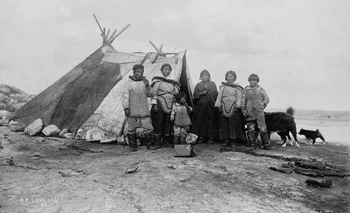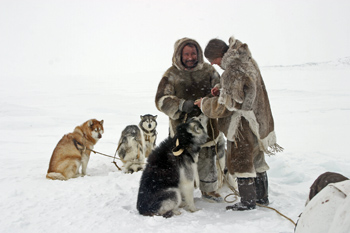From the Editor... Turning Dreams into Reality
In the News
Return of the Far Fur Country Project Update
Another Inuktitut Word for Snow
A Condo for Dogs: The Evolution of Our Dog Houses
Antiquity of the Inuit Sled Dog Supported by Recent Ancient DNA Studies
A Different Type of Sledding
Astrup’s Harness: A personal voyage to understand an old sealskin sled dog harness, Part 2
Movie Review: The Stories of Tuktu: Tuktu and His Eskimo Dogs
IMHO.... Why do we do this?
Navigating This Site
Index of articles by subject
Index of back issues by volume number
Search The Fan Hitch
Articles to download and print
Ordering Ken MacRury's Thesis
Our comprehensive list of resources
Defining the Inuit Dog
Talk to The Fan Hitch
The Fan Hitch home page
Editor: Sue Hamilton
Webmaster: Mark Hamilton
The Fan Hitch,
Journal of the Inuit Sled Dog, is published four times a
year. It is available at no cost online at: https://thefanhitch.org.
The Fan Hitch welcomes your letters, stories, comments and suggestions. The editorial staff reserves the right to edit submissions used for publication.
Contents of The Fan Hitch are protected by international copyright laws. No photo, drawing or text may be reproduced in any form without written consent. Webmasters please note: written consent is necessary before linking this site to yours! Please forward requests to Sue Hamilton, 55 Town Line Rd., Harwinton, Connecticut 06791, USA or mail@thefanhitch.org.
This site is dedicated to the Inuit Dog as well as related Inuit culture and traditions. It is also home to The Fan Hitch, Journal of the Inuit Sled Dog.
The Fan Hitch welcomes your letters, stories, comments and suggestions. The editorial staff reserves the right to edit submissions used for publication.
Contents of The Fan Hitch are protected by international copyright laws. No photo, drawing or text may be reproduced in any form without written consent. Webmasters please note: written consent is necessary before linking this site to yours! Please forward requests to Sue Hamilton, 55 Town Line Rd., Harwinton, Connecticut 06791, USA or mail@thefanhitch.org.
This site is dedicated to the Inuit Dog as well as related Inuit culture and traditions. It is also home to The Fan Hitch, Journal of the Inuit Sled Dog.
 Group of Inuit, Fort Chimo (Kuujjuaq) Nunavik, 1896. A.P. Low, Library and Archives Canada Antiquity of the Inuit Sled Dog Supported by Recent Ancient DNA Studies Sarah K. Brown Anthropology and Veterinary Genetics, University of California, Davis |
The history of dog sledding in the Arctic goes back roughly 1,500 years and is intimately tied to the Thule peoples, the ancestors of Inuit. The Paleoeskimo, who arrived in the North American Arctic roughly 4,500 years ago, show little evidence for having used dog traction or even the presence of dogs in their camps. The Thule peoples innovated transportation in the Arctic by focusing on dog-sled traction, probably one of the reasons they were so successful. Many questions surrounding the presence of dogs in the Arctic remain: 1) where did the Inuit Sled Dog originate?, 2) is there any connection between Paleoeskimo dogs (or their human companions) and Thule era dogs, and 3) are modern Inuit Sled Dogs descended from these ancient Thule dogs? The Mammalian Ecology and Conservation laboratory in conjunction with the Department of Anthropology at the University of California, Davis, are investigating these questions through genetic and archaeological analysis. We are accomplishing this by analyzing both modern Inuit Sled Dogs and ancient dog remains from archaeological sites across Arctic North America. We have collected dog skeletal remains from various archaeological sites Alaska, Canada, and Greenland ranging between ~ 4,000 years old (early Paleoeskimo site in Canada) and ~ 1,000 years old (Thule/Inuit sites).
Our recent publication in the Journal of Archaeological Science (Brown et al. 2013) compared genetic profiles from archaeological specimens recovered from western Alaska and Northwest Greenland (between AD 1250‒1910) to those of modern Inuit Sled Dogs. Our goal was to assess genetic continuity between dogs of the Thule and Inuit, and, more recently, whether ancient genetic ancestry has been replaced by post-colonial European breeds. To this end, we analyzed 21 pre-contact and 3 post-contact dog skeletal remains from three sites in the Arctic. One site was located in Cape Espenberg, the farthest southwestern extent of Kotzebue Sound, Alaska. Dog remains came from three houses, ranging in age between AD 1260‒1800. Cape Espenberg was compared to two locations in Northwest Greenland, Etah and Qaqaistut. The remains of one house and cache, dated between AD 1275‒1440, were excavated at Qaqaistut. At Etah, two houses were excavated, aged between 1250-1650 and 1850-1900. A total of 24 dog bone samples from the excavated material utilized, 12 from Cape Espenberg and 12 from NW Greenland (7 from Qaqaistut and 5 from Etah – 4 of which are post-contact). Our pre and post-contact archaeological samples were compared to a collection of 51 modern Canadian Inuit and Greenland Inuit Sled Dogs (considered one breed, the Inuit Sled Dog – based on Andersen 2005) and 26 Alaskan Malamutes. To determine the ancestry of both the archaeological and modern dogs, we utilized a small portion of the mitochondrial DNA. Mitochondria are organelles, present in every cell, sometimes referred to as the “powerhouse” of the cell. These mitochondria contain a genome (separate from the nuclear DNA) that is maternally inherited and accumulate mutations, or variations, more frequently than nuclear DNA. Because of the relatively rapid mutation rate, mitochondrial DNA is often used to trace ancestry and origin of organisms.
Because DNA degrades over time, eventually leaving only trace amounts behind, archaeological DNA is especially vulnerable to contamination from modern sources. Therefore, we took special precautions when extracting ancient DNA to safeguard against contamination. We extracted all ancient samples in a special, isolated laboratory where no modern DNA has ever been present. All DNA samples, modern and ancient were amplified for a small length (~370 nucleotide-long) of DNA from the mitochondrial genome. We then compared nucleotide sequences of these fragments to a database of worldwide dog sequences to determine if any of our samples matched known sequences. Such sequences can vary by one or many nucleotide changes.
We successfully sequenced 23 archaeological (ca. AD 1250-1910) and recent (ca. AD 1930-1990) surface-collected Canis bone and tooth samples. Ancient samples from Alaska (n=3) and Greenland (n=9) and modern sequences from Greenland (n=41) all contained a high frequency of a sequence named “A31,” which was previously described only in modern North American Arctic dogs. Thus, A31 represented a common thread tying dogs of the entire North American Arctic together prior to European colonization and, in the Eastern Arctic, indicated genetic continuity between past (~800 years) and present dogs as well. Previous research showed that the genetic signature of other ancient native North American breeds had been erased by introgression from westernized breeds. It appears that the isolated nature of Greenland and the high Arctic in Canada helped Inuit Sled Dog escape a similar fate.
Of the twenty-six Alaskan Malamutes, only one individual possessed the A31 haplotype, suggesting that this haplotype is not a common one in the Malamute breed. The most common haplotype was A29, which is also prevalent in Siberian and Alaskan Huskies and has an origin in South East Asia.

The Northwinds Canadian Inuit Dog team with Eric McNair-Landry (r)
and an Inuk actor on the set of the movie Karluk, the flagship of the
Canadian Arctic Expedition that became trapped in arctic pack ice,
drifted for months and was crushed and sunk in January 1914.
Photo: M. McNair
We are continuing our ancient DNA work by performing similar analyses on ancient dog remains from additional sites in Alaska and Canada from both Paleoeskimo and Thule-aged sites. Our modern DNA samples are being put to use as well. We are amplifying a large and variable region of the mitochondrial DNA to help determine how long the A31 haplotype has been in existence. We are also utilizing Y chromosome DNA (paternal lineage) to further elucidate timing and origin of the Inuit Sled Dogs.
Genetic analysis has shown what most Inuit Sled Dog owners have no doubt felt in their heart – that these dogs are embedded in antiquity, tracing their lineages ~800 years to the past. With the help of Inuit and breed enthusiasts, this powerful and ancient breed can continue to brave the elements for years to come.
References:
Brown, S. K., C. M. Darwent, and B. N. Sacks. 2013. Ancient DNA Evidence for Genetic Continuity in Arctic Dogs. Journal of Archaeological Science 40(2): 1279–1288.